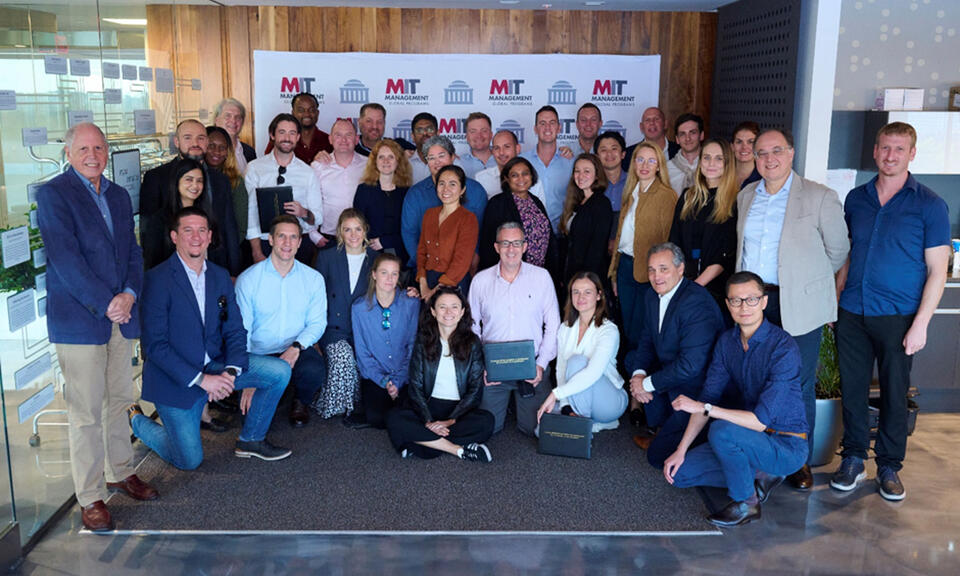Technology and innovation in the US: my Executive MBA international residency experience

Executive MBA students complete a one-week international residency, visiting top business schools and organisations and gaining first-hand experience of international business contexts in other countries. In this blog, Executive MBA student Georges Panaghoulis shares his experience after attending the international residency in the US where the cohort visited MIT – Massachusetts Institute of Technology in Boston and Stanford University in San Fransisco. Georges reflects on the transformative experience of engaging with industry experts and professors and how the trip enriched his understanding of global business and leadership.
Georges Panaghoulis
Nationality: French, Greek
Education: Polytech Marseille
Company and role: Island Oil, Head of Price Risk and Hedging
My highlights of the residency
The first segment of our Executive MBA's international residency took us to the United States, where we delved into the innovation hubs of MIT in Boston and Stanford University in Silicon Valley. These institutions are more than just academic powerhouses; they are dynamic ecosystems driving real-world innovation. Our residency melded theoretical knowledge with hands-on practices, illuminating the entire innovation lifecycle from ideation to execution. A pivotal insight was the cultural embrace of risk-taking and failure, not as setbacks but as integral parts of the innovative journey. Standout experiences included our visits to the SRI and Plug & Play Institute, where we observed how startups pitch to investors and how these institutions foster rapid innovation.
“Residencies offer invaluable opportunities to witness innovation and business success across different cultures, particularly in the US. These experiences broaden your perspective, provide expert insights, and allow for personal and professional growth.”
How this residency contributed to my learning
The residency enriched my understanding of global business and leadership, especially in the context of American market dynamics. The key lessons included the emphasis on diversity, flexibility, and market orientation in U.S. companies, demonstrated during our visit to Sanofi and through interactions with venture capitalists. Stanford's sessions on innovation, risk management, and a workshop on business ethics provided new perspectives on leadership, stressing the importance of ethical decision-making and the power of a supportive network in fostering innovation.
The opportunity to interact with industry experts and professors
Engaging with experts like Phill Budden, Stuart Krusell, Fiona Murray, and Scott Stern at MIT, and Riitta Katila at Stanford, was enlightening. Their diverse perspectives on building successful innovation ecosystems, deep tech innovation, entrepreneurial strategy, and overcoming organisational innovation struggles provided invaluable insights. These interactions underscored the significance of collaboration, big-picture thinking, and creating safe environments for innovation.
Tom Byers' course on entrepreneurial ecosystems and Brandon Farwell’s workshop on business ethics were particularly impactful. They provided deep dives into the essential components of successful ventures and the ethical considerations vital in today's complex business world.


Exposure to the US business environment
My exposure to the US business environment highlighted the importance of embracing risk, being agile, and market focused. Insights gained from practical experiences at SRI, startup pitches at Plug & Play, and discussions on innovation and venture capitalism emphasised the need for efficiency, strong networking, and the art of storytelling in business.
Collaborative projects
Participating in Dr. Jason Jay’s sustainability simulation, discussions with MIT EMBA students, and conversations on venture capitalism and innovation in Silicon Valley were transformative. These activities not only provided theoretical knowledge but also practical experience in problem-solving, collaboration, and understanding the venture lifecycle from idea generation to commercialization.


Exploring the US, outside the classroom
The residency extended beyond academic pursuits, allowing me to explore various parts of the US. Our academic director, Ian Mackenzie, graciously guided us on an informative tour of Harvard, where he previously taught, and through the historic city of Boston.
Our cohort embarked on memorable travels to Half Moon Bay, San Francisco and Napa Valley. These excursions were filled with a variety of social activities, including dinners, swimming, cycling, wine tasting and vibrant parties. My trip then concluded with a few days in Southern California.
My advice to future MBA students
I strongly recommend embracing international residencies. They offer invaluable opportunities to witness innovation and business success across different cultures, particularly in the US. These experiences broaden your perspective, provide expert insights, and allow for personal and professional growth.





